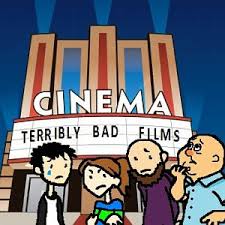A movie can be so bad that it becomes Brilliant ?

The question may sound strange, but the answer is “absolutely yes” – exemples are enormous.
Snakes On A Plane (with an estimable budget of 35 million dollars, which brought an income of 62 million) – the use of snakes on a flight to silence a witness to a murder – Directed by David R. Ellis (2006), The Blair Witch Project (the “art” of making less than $ 30,000 into 250 million …) – A group of students who disappear while investigating a local legend – Directed by Eduardo Sánchez and Daniel Myrick (1999) , Sharknado – A story about sharks, that after a hurricane literally land in Los Angeles – (cost $ 200,000 and is estimated to have yielded about 20 million) – Directed by Anthony C. Ferrante (2013), Friday the 13th (income of 40 million for a cost of half a million) – A group of young victims of a serial killer, without any plausible explanation – Directed by Sean S. Cunningham (1980), The Chainsaw Texas Massacre ($ 150,000 budget for revenues of 100 million) – A Serial Killer from a family of cannibals – Directed by Tobe Hooper (1974), and the list could go on “ad eternum”:
What is the recipe? Well, it changes – Or the story is sold as genuine, or the argument is so bad that it leaves the moviegoer wondering how this was possible (and ultimately think it was deliberate, as he used to write better compositions in primary…), or technically everything is so limited that it seems impossible (and once again the moviegoer believes it was deliberate, because he could do a homemade movie much better).
In reality what we have are “cult films”, which are so bad that let us think about the real motivations – Exception to Snakes on a Plane (too “expensive” for his gender), the other 4 cost less than $ 1 million and yielded more than 400 million.
Isn´t this Brilliant? …
Versão (adaptada) em Português
Pode um filme ser tão mau que se torne brilhante ?
A pergunta pode soar estranha, mas a resposta é "claro que sim" - Exemplos são aos "pontapés":
Serpentes A Bordo (com um estimável orçamento de 35 milhões de dólares, os quais proporcionaram uma receita de 62 milhões) - a utilização de cobras num vôo para calar uma testemunha de um homicídio, O Projecto Blair Witch ( a "arte" de transformar menos de 30 mil dólares em 250 milhões...) - Um grupo de estudantes que desaparece enquanto investiga uma lenda local, Sharknado - uma história sobre tubarões que após um furacão, literalmente aterram em Los Angeles - (custou 200 mil dólares e estima-se que tenha rendido cerca de 20 milhões), Sexta Feira 13 (receita de 40 milhões para um custo de meio milhão) - Um grupo de jovens vítima de um serial killer, sem qualquer explicação plausível, Massacre No Texas (150 mil dólares de orçamento para uma receita de 100 milhões) - Um Serial Killer proveniente de uma família de canibais, e poderia continuar a lista "ad eternum".
Qual é a receita? Pois bem, varia - Ou a história é vendida como verdadeira, ou o argumento é tão mau que deixa o cinéfilo a pensar como tal foi possível (e acaba por achar que foi deliberado, pois ele próprio escreveu composições melhores na primária), ou tecnicamente é tudo tão limitado que parece impossível (e mais uma vez o cinéfilo acredita que foi propositado, pois ele numa filmagem caseira conseguiria fazer muito melhor).
Na verdade o que temos são "filmes de culto", os quais por muito maus que sejam (e são) deixam-nos a pensar nas reais motivações - Excepção a Serpentes a Bordo (efectivamente "caro" para o seu género), os outros 4 custaram menos de 1 milhão de dólares e renderam mais de 400 milhões...
Não será isto brilhante?
Subsídios do Estado? - Não brinquem comigo...
Pode um filme ser tão mau que se torne brilhante ?
A pergunta pode soar estranha, mas a resposta é "claro que sim" - Exemplos são aos "pontapés":
Serpentes A Bordo (com um estimável orçamento de 35 milhões de dólares, os quais proporcionaram uma receita de 62 milhões) - a utilização de cobras num vôo para calar uma testemunha de um homicídio, O Projecto Blair Witch ( a "arte" de transformar menos de 30 mil dólares em 250 milhões...) - Um grupo de estudantes que desaparece enquanto investiga uma lenda local, Sharknado - uma história sobre tubarões que após um furacão, literalmente aterram em Los Angeles - (custou 200 mil dólares e estima-se que tenha rendido cerca de 20 milhões), Sexta Feira 13 (receita de 40 milhões para um custo de meio milhão) - Um grupo de jovens vítima de um serial killer, sem qualquer explicação plausível, Massacre No Texas (150 mil dólares de orçamento para uma receita de 100 milhões) - Um Serial Killer proveniente de uma família de canibais, e poderia continuar a lista "ad eternum".
Qual é a receita? Pois bem, varia - Ou a história é vendida como verdadeira, ou o argumento é tão mau que deixa o cinéfilo a pensar como tal foi possível (e acaba por achar que foi deliberado, pois ele próprio escreveu composições melhores na primária), ou tecnicamente é tudo tão limitado que parece impossível (e mais uma vez o cinéfilo acredita que foi propositado, pois ele numa filmagem caseira conseguiria fazer muito melhor).
Na verdade o que temos são "filmes de culto", os quais por muito maus que sejam (e são) deixam-nos a pensar nas reais motivações - Excepção a Serpentes a Bordo (efectivamente "caro" para o seu género), os outros 4 custaram menos de 1 milhão de dólares e renderam mais de 400 milhões...
Não será isto brilhante?
Subsídios do Estado? - Não brinquem comigo...

Sem comentários:
Enviar um comentário